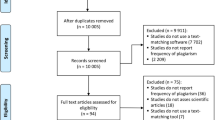Abstract
In papers in areas such as engineering and the physical sciences, figures, tables and formulae are the basic elements to communicate the authors’ core ideas, workings and results. As a computational text-matching tool, CrossCheck cannot work on these non-textual elements to detect plagiarism. Consequently, when comparing engineering or physical sciences papers, CrossCheck may return a low similarity index even when plagiarism has in fact taken place. A case of demonstrated plagiarism involving engineering papers with a low similarity index is discussed, and editor’s experiences and suggestions are given on how to tackle this problem. The case shows a lack of understanding of plagiarism by some authors or editors, and illustrates the difficulty of getting some editors and publishers to take appropriate action. Consequently, authors, journal editors, and reviewers, as well as research institutions all are duty-bound not only to recognize the differences between ethical and unethical behavior in order to protect a healthy research environment, and also to maintain consistent ethical publishing standards.
Similar content being viewed by others
Notes
OSI: The overall similarity index (OSI) is the percentage of similarity between a submission and information existing in the iThenticate databases selected as search targets (CrossCheck_Manual; Zhang and Jia 2012).
SMSI: The single match similarity index (SMSI) is the percentage of similarity from a single source between a submission and information existing in the iThenticate databases selected as search targets (CrossCheck_Manual; Zhang and Jia 2012).
References
Abdelmoneim, S. E. (2010). Plagiarism: What is it? How to avoid it? 14th Alexandria Anaesthesia & Intensive Care Conference. Alexandria Faculty of Medicine. Available from http://www.alexaic.com/alexaicfiles/presentation2010/day3/028001.pdf. Accessed 1 August 2012.
Baždarić, K., Bilić-Zulle, L., Brumini, G., & Petrovečki, M. (2012). Prevalence of plagiarism in recent submissions to the Croatian medical journal. Science Engineering Ethics, 18, 223–239. doi:10.1007/s11948-011-9347-2.
Bouville, M. (2008). Plagiarism: Words and ideas. Science Engineering Ethics, 14, 311–322. doi:10.1007/s11948-008-9057-6.
Brinkman, B. (2013). An analysis of student privacy rights in the use of plagiarism detection systems. Science Engineering Ethics, 19, 1255–1266.
Bugeja, M. (2012). Busting the new breed of plagiarist. http://www.awpwriter.org/magazine/writers/mbugeja01.htm. Accessed 5 July 2013.
Butler, D. (2010). Journals step up plagiarism policing cut-and-paste culture tackled by CrossCheck software. Nature, 466, 167. doi:10.1038/466167a.
Carraway, L. N. (2009). Ethics for and responsibilities of authors, reviewers and editors in science. The American Midland Naturalist, 161, 146–164.
COPE. (2010). CrossCheck guidance: An analysis of typical cases of plagiarism in different disciplines. Available from http://publicationethics.org/resources/research. Accessed on 13 July 2013.
COPE. (2011). Code of conduct and best practice guidelines for journal editors. Available from http://publicationethics.org/files/Code_of_conduct_for_journal_editors.pdf. Accessed 4 July 2012.
CrossCheck_Manual. (2012). Available from http://www.crossref.org/crosscheck/CrossCheck_Manual.pdf. Accessed 4 September 2012.
Garner, H. R. (2011). Combating unethical publications with plagiarism detection services. Urology and Oncology, 29(1), 95–99.
Garner, H., Pulverer, B., Marušić, A., Petrovečki, M., Loadsman, J., Zhang, Y. H., et al. (2012). Comment: How to stop plagiarism. Nature, 481, 21–23.
Greetham, B. (2008). How to write better essays (2nd ed.). Basingstoke, England: Palgrave.
Hames, I. (2007). Peer review and manuscript management in scientific journals: Guidelines for good practice (1st ed.). Oxford: Wiley.
IEEE CrossCheck user’s guide. (2012). Available from http://www.ieee.org/documents/CrossCheck_User_Guide_S1M119068.pdf. Accessed 4 September 2012.
Jia, X. Y., Tan, X. F., & Zhang, Y. H. (2013). Replication of the methods section in biosciences papers: Is it plagiarism? Scientometrics. doi:10.1007/s11192-013-1033-5.
Li, Y. Y. (2012). Text-based plagiarism in scientific publishing: Issues, developments and education. Science Engineering Ethics, 19(2), 569–583. doi:10.1007/s11948-012-9367-6.
Maurer, H., Kappe, F., & Zaka, B. (2006). Plagiarism-A Survey. Journal of Universal Computer Science, 12(8), 1050–1084.
Morris, S., Barnas, E., La Frenier, D., & Reich, M. (2013). The handbook of journal publishing. Cambridge: Cambridge University Press.
Plagiarism FAQs. (2013). Available from http://plagiarism.org/ask-the-experts/faq. Accessed 10 April 2013.
Sox, H. C., & Rennie, D. (2006). Research misconduct, retraction, and cleansing the medical literature. Lessons from the Poehlman case. Annuals of Internal Medicine, 144, 609–613.
Wager, E. (2011). How should editors respond to plagiarism? Available from http://publicationethics.org/files/Discussion%20document.pdf. Accessed 11 August 2012.
Wager, E., & Williams, P. (2011). Why and how do journals retract articles? An analysis of Medline retractions 1988–2008. Journal of Medical Ethics, 37, 567–570.
Watson, R., & Hayter, M. (2013). Halt fraud before it hits the headlines. Times Higher Education, April 4, 2013. Available from http://www.timeshighereducation.co.uk/comment/opinion/halt-fraud-before-it-hits-the-headlines/2002887.article. Accessed 15 April 2013.
Zhang, Y. H. (2010a). CrossCheck: An effective tool for detecting plagiarism. Learned Publishing, 23, 9–14. doi:10.1087/20100103.
Zhang, Y. H. (2010b). Chinese journal finds 31 % of submissions plagiarized. Nature, 467(9), 153.
Zhang, Y. H., & Jia, X. Y. (2012). A survey on the use of CrossCheck for detecting plagiarism in journal articles. Learned publishing, 25(4), 292–307.
Zhang, Y. H., & Jia, X. Y. (2013). Republication of conference papers in journals? Learned Publishing, 26(3), 189–196.
Zhang, Y. H., Jia, X. Y., Lin, H. F., & Tan, X. F. (2013). Editorial: Be careful! Avoiding duplication: A case study. Journal of Zhejiang University-SCIENCE B (Biomedicine & Biotechnology), 14(4), 355–358. doi:10.1631/jzus.B1300078.
Acknowledgments
We especially thank Sally MORRIS, UK for professional guidance and English polishing. This work is a part of a research study commissioned by the Committee on Publication Ethics (COPE) with the aim of developing evidence-based guidance for different scientific subject journal editors on how to deal with different kinds of plagiarism detected through the use of CrossCheck (http://publicationethics.org/resources/research).
Author information
Authors and Affiliations
Corresponding author
Rights and permissions
About this article
Cite this article
Zhang, Xx., Huo, Zl. & Zhang, Yh. Detecting and (Not) Dealing with Plagiarism in an Engineering Paper: Beyond CrossCheck—A Case Study. Sci Eng Ethics 20, 433–443 (2014). https://doi.org/10.1007/s11948-013-9460-5
Received:
Accepted:
Published:
Issue Date:
DOI: https://doi.org/10.1007/s11948-013-9460-5




